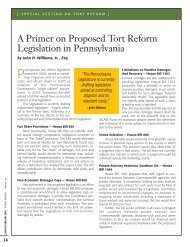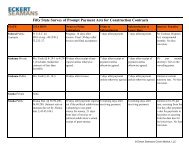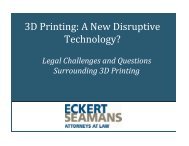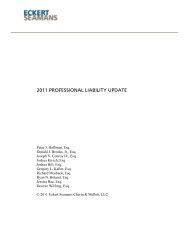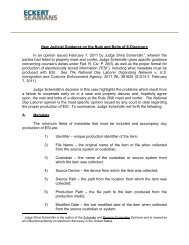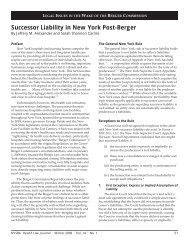civil enforcement provisions and made it clear that state authorities retained the power tocreate civil enforcement provisions. Id. at *13. Consequently, the federal informed consentregulations were not exclusive. Id. All of these factors, the court reasoned, indicated thatCongress did not intend informed consent for human research subjects to be a significantfederal issue to be resolved by federal courts. Id. Consequently, MCARE’s informedconsent provisions were not preempted by federal law and no federal question waspresented to support federal question jurisdiction. Id.(b)Punitive DamagesMCARE also makes changes to Pennsylvania’s law related to the imposition of punitivedamages. Under the new law, punitive damages may be awarded for conduct that is the result ofthe health care provider’s “willful or wanton conduct, or reckless indifference to the rights ofothers.” 40 P.S. § 1303.505(a). A showing of gross negligence is insufficient to supportpunitive damages. 40 P.S. § 1303.505(b). Furthermore, punitive damages shall not be awardedagainst a health care provider who is only vicariously liable for the actions of its agent thatcaused the injury unless it can be shown by a preponderance of the evidence that the party knewof and allowed the conduct by its agent that resulted in the award of punitive damages. 40 P.S. §1303.505(c). Except in cases alleging intentional misconduct, the punitive damage award shallnot exceed two hundred percent of the amount of compensatory damages awarded. 40 P.S. §1303.505(d). For causes of actions arising after March 20, 2002, MCARE allocates twenty-fivepercent of the punitive damage award to the Medical Care Availability and Reduction of ErrorFund, while the remaining seventy-five percent is paid to the prevailing party. 40 P.S. §1303.505(e). (The MCARE Fund is discussed in greater detail below.)A recent case in the Eastern District of Pennsylvania addressed the issue of punitivedamages in a medical malpractice action. See Stroud v. Abington Mem’l Hosp., 546 F. Supp. 2d238 (E.D. Pa. 2008). In Stroud, defendants argued that Plaintiff’s claims, which were basedupon Defendants’ alleged failure to diagnose the decedent’s obstructed bowel, amounted tonegligence at most and, therefore, did not support punitive damages. See id. As such,defendants filed a Motion to Dismiss Plaintiff’s punitive damages claim. 9 See id. Plaintiffcountered that his pleading was sufficient to support a claim for punitive damages. Plaintiff alsoasserted that he was further entitled to a claim for punitive damages based upon Defendants’alleged “cover up” of their prior negligence. See id.The District Court, applying Pennsylvania law, held that Plaintiff had sufficiently pled aclaim for punitive damages to survive a motion to dismiss. See id. at 256-57. The Courtrecognized that although the MCARE Act and Pennsylvania case law impose a substantialburden on a plaintiff seeking to prove his entitlement to punitive damages, Plaintiff hadsufficiently pled a claim for punitive damages pursuant to the notice pleading requirements of theFederal Rules of Civil Procedure. See id. at 257. The Court emphasized, however, that its rulingwas without prejudice and that moving defendants would be entitled to seek furtherconsideration of the punitive damages question at the appropriate later stage of the proceedings.See id. at 257-58.9 The District Court in Stroud also addressed the adequacy of Plaintiff’s Certificate of Merit. The court’s analysisand holding with respect to the Certificate of Merit issue is addressed in another section.98
With respect to Plaintiff’s contention that Defendants’ actions “covering up” their allegednegligence supported a claim for punitive damages, the District Court held that any alleged“covering up” of negligence by Defendants was independent from the underlying tort claimsupon which Plaintiff’s recovery was premised. See id. at 259. Citing Pennsylvania law, theCourt noted that punitive damages are “merely an additional element of damages that may berecovered on an appropriate cause of action.” See id. at 258. Thus, guided by the Superior Courtand the Third Circuit, the District Court granted moving defendants’ motion to dismiss plaintiff’sclaim for punitive damages premised on the theory defendants acted to cover up their priornegligence. See id.(c)Collateral Source RuleMCARE also makes noteworthy changes to the collateral source rule, which prior toMCARE, often permitted double recovery of economic damages by plaintiffs. Under the newlaw, a plaintiff is precluded from recovering damages for past medical expenses or past lostearnings to the extent the loss is paid by public or private insurance prior to trial. 40 P.S. §1303.508(a). While the plaintiff has the option to introduce into evidence the total amount ofmedical expenses he actually incurred, his right to recover is limited to only the total of thoseexpenses for which the plaintiff is personally responsible. 40 P.S. § 1303.508 (b). Additionally,an insurer has no right of subrogation or reimbursement from a plaintiff’s tort recovery. 40 P.S.§ 1303.508(c). However, there are many kinds of payments that do not reduce recoverablemedical bills. Exceptions to the revised collateral source rule (and thus recoverable by theplaintiff) include life insurance benefits, pension and profit sharing payments, deferredcompensation arrangements, social security benefits, medical assistance payments (DPW), andpublic benefits paid under a program to which ERISA and other federal law preempts state law.40 P.S. § 1303.508(d)(1)-(4).(d)Calculation of DamagesUnder MCARE, juries are asked to separately enumerate a specific dollar amount for sixdifferent categories of potential damages (past and future medical expenses, past and future lostearnings, and past and future non-economic damages such as pain and suffering). 40 P.S. §1303.509(a). Juries have to specify future medical expenses for each year. 40 P.S. § 1303.509(a)(2)(i). For jurors, MCARE means that instead of reaching a consensus on one number totalingdamages for future medical expenses, they will have to reach an agreement on six differentcategories of damages.For causes of action arising after March 20, 2002, MCARE also changes the manner inwhich judgments including future lost earnings and future medical expenses are calculated.Instead of the former calculation method where future inflation was deemed to be equal to futureinterest rates, future lost income is to be reduced to present values based upon the return that theclaimant can earn on a reasonably secure fixed income investment. 40 P.S. § 1303.510. Expertevidence will still be admissible with regards to the effects of productivity and inflation overtime. Id. Further, evidence of future wage loss must be supported by expert testimony. SeeHartenstine v. Daneshdoost, 4 Pa. D. & C. 5th 282 (C.P. Lehigh 2008).99
- Page 3 and 4:
EMTALA CASES ......................
- Page 5:
Filing an Affidavit of Non-Involvem
- Page 8 and 9:
II.PROFESSIONAL LIABILITY - AN OVER
- Page 10 and 11:
The Superior Court reversed the tri
- Page 12 and 13:
to a third party pursuant to the st
- Page 14 and 15:
After approximately five months, De
- Page 16 and 17:
learned the day after the surgery t
- Page 18 and 19:
conduct to the delay in colon cance
- Page 20 and 21:
court admitted the expert’s testi
- Page 22 and 23:
(b)(c)other reasonable causes, incl
- Page 24 and 25:
corroborated his testimony. The cou
- Page 26 and 27:
husband’s estate. Plaintiff alleg
- Page 28 and 29:
Other notable federal cases arising
- Page 30 and 31:
The Superior Court found that in re
- Page 32 and 33:
§ 1303.512(b). The court, however,
- Page 34 and 35:
In Neidig v. United States, No. 07-
- Page 36 and 37:
Additionally, the Supreme Court not
- Page 38 and 39:
were not indicated for her conditio
- Page 40 and 41:
surgeon is the same as it would be
- Page 42 and 43:
It should be noted that the Superio
- Page 44 and 45:
Finally, the court held that the tr
- Page 46 and 47:
The Supreme Court of Pennsylvania r
- Page 48 and 49:
nurses deviating from applicable st
- Page 50 and 51:
certainty, the court reviews expert
- Page 52 and 53:
Under Pennsylvania law, the Court n
- Page 54 and 55: testimony, Defendant presented his
- Page 56 and 57: Following Cooper v. Roberts, 286 A.
- Page 58 and 59: Plaintiff developed chronic diarrhe
- Page 60 and 61: where payment is made by Medicaid w
- Page 62 and 63: accomplished. In Valles v. Albert E
- Page 64 and 65: In 1980, the Pennsylvania Superior
- Page 66 and 67: Plaintiff had a routine monitoring
- Page 68 and 69: Plaintiff’s Contract ClaimsThe Co
- Page 70 and 71: is a failure to report changes in a
- Page 72 and 73: unit to assure post-surgical patien
- Page 74 and 75: sliced his wrist and arm with a raz
- Page 76 and 77: licensed professionals for whom the
- Page 78 and 79: (c)Limitations of Corporate Neglige
- Page 80 and 81: Even more recently, our Superior Co
- Page 82 and 83: (a)HMO IssuesIn McClellan v. Health
- Page 84 and 85: affidavit submitted by Defendants o
- Page 86 and 87: treatments while at VA’s faciliti
- Page 88 and 89: [s]ubstantively, we believe that a
- Page 90 and 91: The party claiming the benefit of t
- Page 92 and 93: deprive (him) of civil rights guara
- Page 94 and 95: found that the District Court was w
- Page 96 and 97: With respect to fraudulent concealm
- Page 98 and 99: would be applied in situations wher
- Page 100 and 101: they had not raised them in the cou
- Page 102 and 103: (a)Informed ConsentUnder MCARE, a p
- Page 106 and 107: MCARE also changes the manner in wh
- Page 108 and 109: whose death, in 2005, was allegedly
- Page 110 and 111: vicariously liable if the plaintiff
- Page 112 and 113: health center or its equivalent or
- Page 114 and 115: In Pennsylvania Medical Society, th
- Page 116 and 117: to any professional who is alleged
- Page 118 and 119: Since the 2005 amendments, there ha
- Page 120 and 121: ule, but who intentionally ignores
- Page 122 and 123: the original Complaint was delivere
- Page 124 and 125: foreclose all challenges against th
- Page 126 and 127: number of boxes), which was support
- Page 128 and 129: questions of professional judgment
- Page 130 and 131: deviated from any professional stan
- Page 132 and 133: The Third Circuit affirmed the Dist
- Page 134 and 135: claims and cross-claims remain agai
- Page 136 and 137: By an Amendatory Order dated March
- Page 138 and 139: The court acknowledged that there i
- Page 140 and 141: apply and that the trial court misa
- Page 142 and 143: Barbados had enough litigation-spec
- Page 144 and 145: E. Preemption of Vaccine Design Def
- Page 146 and 147: 2. Pa. R. Civ. Pro. 1036.1 - Reinst
- Page 148 and 149: Barrick, at *34-35.Furthermore, the
- Page 150 and 151: (b) the utility of the defendant’
- Page 152 and 153: 2006). In this case, Plaintiffs bro
- Page 154 and 155:
B. Elements of a Cause of Action fo
- Page 156 and 157:
decision in Muhammad precluded Mr.
- Page 158 and 159:
considered speculative “only if t
- Page 160 and 161:
underlying cause of action involved
- Page 162 and 163:
In Capital Care Corp., the Superior
- Page 164 and 165:
The court found, however, to state
- Page 166 and 167:
of reasonable diligence. The standa
- Page 168 and 169:
not be set aside. On July 7, 2005,
- Page 170 and 171:
complete bar to recovery. Since a l
- Page 172 and 173:
On appeal, Plaintiffs claimed that
- Page 174 and 175:
In Liggon-Redding, 659 F.3d at 265,
- Page 176 and 177:
elieved of those minimum standards
- Page 178 and 179:
elevant to the proceedings, the com
- Page 180 and 181:
establish professional misconduct b
- Page 182 and 183:
Upholding the Superior Court’s Or
- Page 184 and 185:
Id.Rejecting revocation and suspens
- Page 186 and 187:
order as a sanction under Rule 4019
- Page 188:
{1009912]182



